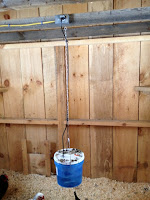The third week of January is always the coldest time in New England. Mt Washington was -70F and Unity Farm was 1.4F
When we began this season I had no idea how to keep the animals happy and healthy in near zero temperatures. We've learned a great deal and thus far, everything has worked.
 Chickens and Guinea Fowl - I've written about keeping warm in New England, highlighting that convective, conductive, and radiated heat loss need to be controlled. For poultry, a dry, wind free coop with off ground roosting helps a great deal. Our chicken breeds are very cold hardy due to their small combs and waddles. However, to completely guard against frostbite, we added 150 watt sealed heating panels to the roof and baseboard of the coop (photo below). These are thermostatically controlled and go on at 35F, off at 45F They've worked perfectly, ensuing the coop is 10-15 degrees warmer than the outside temperature. Keeping water supplies liquid at zero F requires planning. For the chickens, their hanging bucket waterer now has a submersible thermostat controlled heater (photo to the right). For the guinea fowl, their standalone waterer sits on a thermostat controlled heat plate. In very cold weather, the guineas rarely leave the coop, enjoying the food, water, and warmth of their gently heated home. I did have to wire the coop with tamper-proof (beak proof), weather resistant (from chicken droppings) outlets and rugged 14 gauge romex wire. Everything has worked without a hitch.
Chickens and Guinea Fowl - I've written about keeping warm in New England, highlighting that convective, conductive, and radiated heat loss need to be controlled. For poultry, a dry, wind free coop with off ground roosting helps a great deal. Our chicken breeds are very cold hardy due to their small combs and waddles. However, to completely guard against frostbite, we added 150 watt sealed heating panels to the roof and baseboard of the coop (photo below). These are thermostatically controlled and go on at 35F, off at 45F They've worked perfectly, ensuing the coop is 10-15 degrees warmer than the outside temperature. Keeping water supplies liquid at zero F requires planning. For the chickens, their hanging bucket waterer now has a submersible thermostat controlled heater (photo to the right). For the guinea fowl, their standalone waterer sits on a thermostat controlled heat plate. In very cold weather, the guineas rarely leave the coop, enjoying the food, water, and warmth of their gently heated home. I did have to wire the coop with tamper-proof (beak proof), weather resistant (from chicken droppings) outlets and rugged 14 gauge romex wire. Everything has worked without a hitch.Dogs - The Great Pyrenees have double coats and really enjoy snow and ice. They eat the "popsicles" from the ice that falls from the barn roof. Just as with the chickens, keeping dogs out of the wind and wet weather is important. We've created spaces for them in the hayloft - they curl up among the bales, staying warm on blustery winter nights. Also, we use a thermostatically controlled heated bucket to keep their water liquid.
Alpaca/Llama - The camelids seem impervious to cold but do not like the wind. We created rubber floored stalls with sliding doors that provide a wind and rain barrier. Their water buckets are heated. We feed them hay with a high percentage of alfalfa (extra calories) on cold days. We feed each of them a cup of high energy grain in the morning and evening of each winter day. We supplement their diet with beet pulp. Shoveling manure during weeks that never rise about freezing has proven to be a challenge. I can use a wrecking bar, pick, or hammer to break up manure, but I've found it more practical to wait until a thaw day to shovel.
The combination of appropriate housing, low wattage heaters, and water management, has proven to me that winter on Unity Farm will pass without any animal health and well-being issues.








